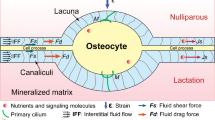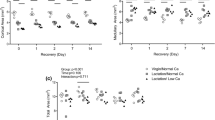Abstract
The vitamin D receptor (VDR) plays an important role in maintaining calcium homeostasis, acting as a mediator of transcellular calcium absorption and bone remodeling. Mice lacking a functional VDR have an abnormal skeletal phenotype, which is rescued by feeding a high-calcium diet. In this study, the role of the VDR in maintaining bone geometry and strength during gestation and lactation, when increased demands are placed on the calcium regulatory channels, was examined using a knockout mouse model. A rescue diet was used to counteract the decrease in calcium absorption in the gut that results from the absence of the VDR. Structural and compositional characteristics of the femur were compared between VDR knockout and wild-type mice following 9 and 16 days of gestation and 5 and 10 days of lactation using generalized linear models. Overall, the knockout mice had 6.5% lower cortical area, 23% lower trabecular volume fraction, and 9% lower bending stiffness than wild-type mice. However, the maximum moment of inertia of the femoral diaphyses, ultimate bending load, ash fraction, and trabecular thickness were not significantly different between knockout and wild-type mice. Only the mineral content exhibited interdependence between genotype and time point. Taken together, the results show that the VDR affects the quantity of mineralized bone tissue in the femoral diaphysis and metaphysis independently of reproductive status. However, the moments of inertia were similar between genotypes, resulting in similar bone stiffness and strength despite lower mineral content and cross-sectional area.





Similar content being viewed by others
References
Garabedian M, Tanaka Y, Holick MF, Deluca HF (1974) Response of intestinal calcium transport and bone calcium mobilization to 1, 25-dihydroxyvitamin D3 in thyroparathyroidectomized rats. Endocrinology 94:1022–1027
Matsumoto T, Igarashi C, Takeuchi Y, Harada S, Kikuchi T, Yamato H, Ogata E (1991) Stimulation by 1,25-dihydroxyvitamin D3 of in vitro mineralization induced by osteoblast-like MC3T3-E1 cells. Bone 12:27–32
Takeda S, Yoshizawa T, Nagai Y, Yamato H, Fukumoto S, Sekine K, Kato S, Matsumoto T, Fujita T (1999) Stimulation of osteoclast formation by 1,25-dihydroxyvitamin D requires its binding to vitamin D receptor (VDR) in osteoblastic cells: studies using VDR knockout mice. Endocrinology 140:1005–1008
Haussler MR, Whitfield GK, Haussler CA, Hsieh JC, Thompson PD, Selznick SH, Dominguez CE, Jurutka PW (1998) The nuclear vitamin D receptor: biological and molecular regulatory properties revealed. J Bone Miner Res 13:325–349
Norman AW (1990) Intestinal calcium absorption: a vitamin D-hormone-mediated adaptive response. Am J Clin Nutr 51:290–300
Bronner F (2003) Mechanisms of intestinal calcium absorption. J Cell Biochem 88:387–393
Van Cromphaut SJ, Dewerchin M, Hoenderop JG, Stockmans I, Van Herck E, Kato S, Bindels RJ, Collen D, Carmeliet P, Bouillon R, Carmeliet G (2001) Duodenal calcium absorption in vitamin D receptor-knockout mice: functional and molecular aspects. Proc Natl Acad Sci USA 98:13324–13329
Li YC, Bolt MJ, Cao LP, Sitrin MD (2001) Effects of vitamin D receptor inactivation on the expression of calbindins and calcium metabolism. Am J Physiol Endocrinol Metab 281:E558–E564
An BS, Choi KC, Kang SK, Lee GS, Hong EJ, Hwang WS, Jeung EB (2003) Mouse calbindin-D(9k) gene expression in the uterus during late pregnancy and lactation. Mol Cell Endocrinol 205:79–88
Amling M, Priemel M, Holzmann T, Chapin K, Rueger JM, Baron R, Demay MB (1999) Rescue of the skeletal phenotype of vitamin D receptor-ablated mice in the setting of normal mineral ion homeostasis: formal histomorphometric and biomechanical analyses. Endocrinology 140:4982–4987
Olausson H, Laskey MA, Goldberg GR, Prentice A (2008) Changes in bone mineral status and bone size during pregnancy and the influences of body weight and calcium intake. Am J Clin Nutr 88:1032–1039
Prentice A (2000) Calcium in pregnancy and lactation. Annu Rev Nutr 20:249–272
Brommage R, DeLuca HF (1985) Regulation of bone mineral loss during lactation. Am J Physiol Endocrinol Metab 248:E182–E187
Halloran BP, DeLuca HF (1980) Skeletal changes during pregnancy and lactation: the role of vitamin D. Endocrinology 107:1923–1929
Ward KA, Adams JE, Mughal MZ (2005) Bone status during adolescence, pregnancy and lactation. Curr Opin Obstet Gynecol 17:435–439
Kalkwarf HJ (1999) Hormonal and dietary regulation of changes in bone density during lactation and after weaning in women. J Mammary Gland Biol Neoplasia 4:319–329
Bezerra FF, Cabello GM, Mendonca LM, Donangelo CM (2008) Bone mass and breast milk calcium concentration are associated with vitamin D receptor gene polymorphisms in adolescent mothers. J Nutr 138:277–281
Miller SC, Halloran BP, DeLuca HF, Jee WS (1982) Role of vitamin D in maternal skeletal changes during pregnancy and lactation: a histomorphometric study. Calcif Tissue Int 34:245–252
Marie PJ, Cancela L, Le Boulch N, Miravet L (1986) Bone changes due to pregnancy and lactation: influence of vitamin D status. Am J Physiol Endocrinol Metab 251:E400–E406
Zeni SN, Di Gregorio S, Mautalen C (1999) Bone mass changes during pregnancy and lactation in the rat. Bone 25:681–685
Song Y, Kato S, Fleet JC (2003) Vitamin D receptor (VDR) knockout mice reveal VDR-independent regulation of intestinal calcium absorption and ECaC2 and calbindin D9k mRNA. J Nutr 133:374–380
Rummens K, van Cromphaut SJ, Carmeliet G, van Herck E, van Bree R, Stockmans I, Bouillon R, Verhaeghe J (2003) Pregnancy in mice lacking the vitamin D receptor: normal maternal skeletal response, but fetal hypomineralization rescued by maternal calcium supplementation. Pediatr Res 54:466–473
Li YC, Pirro AE, Amling M, Delling G, Baron R, Bronson R, Demay MB (1997) Targeted ablation of the vitamin D receptor: an animal model of vitamin D-dependent rickets type II with alopecia. Proc Natl Acad Sci USA 94:9831–9835
Johnson LE, DeLuca HF (2001) Vitamin D receptor null mutant mice fed high levels of calcium are fertile. J Nutr 131:1787–1791
Johnson LE, DeLuca HF (2002) Reproductive defects are corrected in vitamin D-deficient female rats fed a high calcium, phosphorus and lactose diet. J Nutr 132:2270–2273
Zinser GM, Welsh J (2004) Accelerated mammary gland development during pregnancy and delayed postlactational involution in vitamin D3 receptor null mice. Mol Endocrinol 18:2208–2223
Boskey AL (2001) Bone mineralization. In: Cowin SC (ed) Bone mechanics handbook. CRC, Boca Raton, FL, pp 5.1–5.33
Russo CR, Lauretani F, Seeman E, Bartali B, Bandinelli S, Di Iorio A, Guralnik J, Ferrucci L (2006) Structural adaptations to bone loss in aging men and women. Bone 38:112–118
Buckwalter JA, Glimcher MJ, Cooper RR, Recker R (1996) Bone biology. II: Formation, form, modeling, remodeling, and regulation of cell function. Instr Course Lect 45:387–399
Keshawarz NM, Recker RR (1984) Expansion of the medullary cavity at the expense of cortex in postmenopausal osteoporosis. Metab Bone Dis Relat Res 5:223–228
Keller TS, Spengler DM (1989) Regulation of bone stress and strain in the immature and mature rat femur. J Biomech 22:1115–1127
Thomsen JS, Mosekilde L, Boyce RW, Mosekilde E (1994) Stochastic simulation of vertebral trabecular bone remodeling. Bone 15:655–666
Author information
Authors and Affiliations
Corresponding author
Rights and permissions
About this article
Cite this article
Korecki, C.L., Zinser, G., Liu, X. et al. Effect of the Vitamin D Receptor on Bone Geometry and Strength During Gestation and Lactation in Mice. Calcif Tissue Int 85, 405–411 (2009). https://doi.org/10.1007/s00223-009-9281-3
Received:
Accepted:
Published:
Issue Date:
DOI: https://doi.org/10.1007/s00223-009-9281-3




